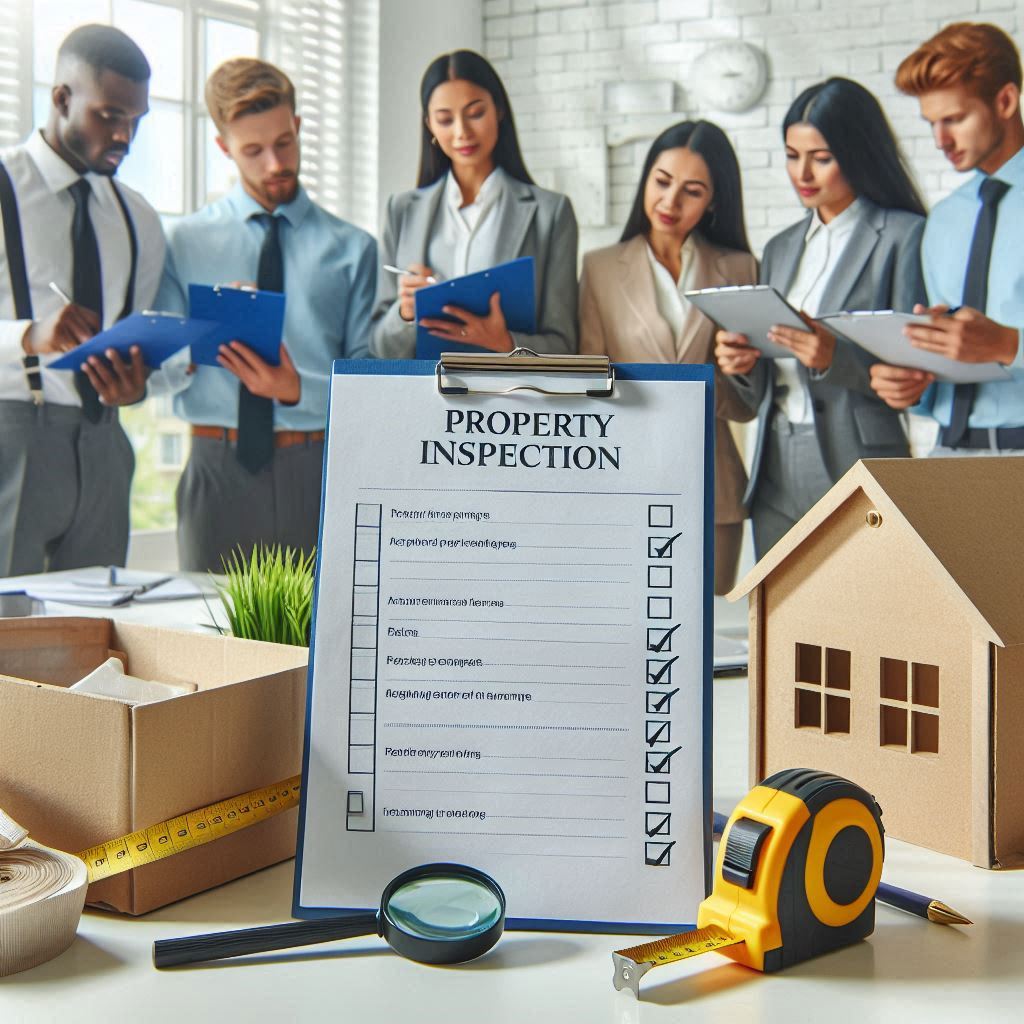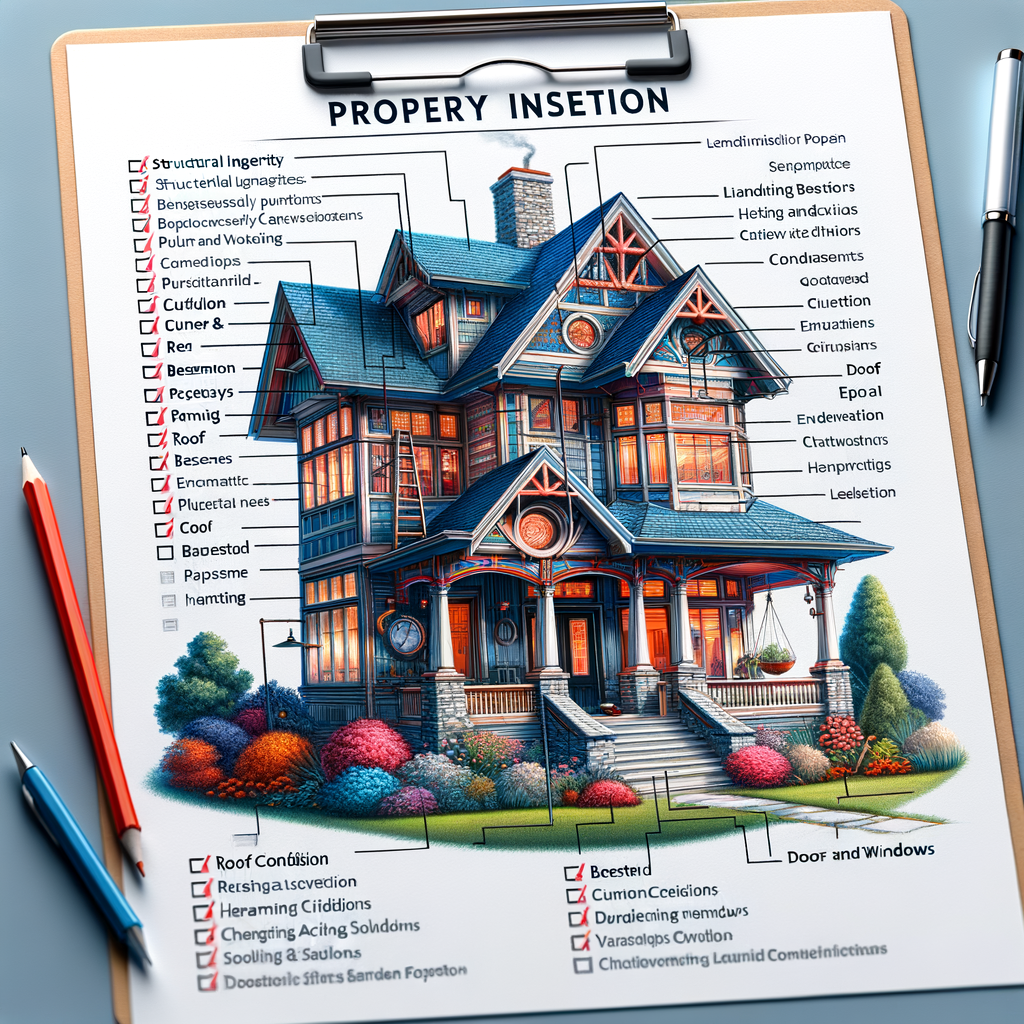Introduction
The Comprehensive Property Inspection Checklist is a guide designed to assist both buyers and sellers in thoroughly assessing the condition of a property. This checklist serves as a comprehensive tool that covers various aspects of a property, enabling users to identify potential issues, evaluate its overall condition, and make informed decisions. Whether you are looking to buy or sell a property, this guide will help ensure that all key areas are examined during the inspection process.

The Importance of a Comprehensive Property Inspection Checklist
A property inspection checklist is an essential tool for both buyers and sellers in the real estate market. It provides a comprehensive overview of the condition of a property, ensuring that all aspects are thoroughly examined and documented. This article will discuss the importance of a comprehensive property inspection checklist and how it benefits both buyers and sellers.
Benefit of Property inspection Checklist
Firstly:
a comprehensive property inspection checklist ensures that all areas of the property are assessed. From the exterior to the interior, every aspect is inspected to identify any potential issues or problems. This includes examining the foundation, roof, plumbing system, electrical system, HVAC systems, as well as other structural components. By following a detailed checklist, inspectors can systematically evaluate each area and provide an accurate report on its condition.
Secondly:
having a thorough inspection conducted using a comprehensive checklist allows buyers to make informed decisions. When purchasing a property, it is crucial to know if there are any underlying issues or defects that may affect its value or pose potential risks in the future. By obtaining an extensive report based on an exhaustive checklist evaluation, buyers can negotiate with sellers regarding repairs or adjustments before finalizing the transaction.
Furthermore, for sellers looking to sell their properties quickly and at higher prices, providing potential buyers with an inspection report based on a complete checklist can greatly enhance their chances. Buyers are more likely to trust sellers who have taken proactive measures by conducting inspections prior to listing their properties on the market. A thorough examination helps build confidence among potential buyers by demonstrating transparency and honesty from the seller’s side.
Moreover,a comprehensive property inspection using a detailed checklist not only benefits individual homebuyers but also serves broader purposes within real estate transactions.Mortgage lenders often require inspections as part of loan approval processes.
Lending Decision and Reports
As such,lenders rely heavily on these reports when making lending decisions.Having completed through checks demonstrates responsible ownership,making borrowers appear reliable and decreasing lender risk.Furthermore,such assessments protect prospective lenders since they give them insights into possible hazards present in the property,like lead paint or asbestos,which could affect its value and pose a risk to occupants.
Real estate agents
In addition to these advantages for buyers and sellers, having a comprehensive inspection checklist also benefits real estate agents. Agents play a vital role in facilitating property transactions, representing both buyers and sellers.

By recommending thorough inspections based on an extensive checklist, agents can help their clients make well-informed decisions while protecting their interests throughout the process. It reflects positively on the agent’s professionalism and dedication to ensuring that clients receive accurate information about properties they are considering.
conclusion
a comprehensive property inspection checklist is an indispensable tool for both buyers and sellers in the real estate market.With detailed evaluations of every aspect of a property’s condition,it provides essential information for making informed decisions.It enables potential issues to be identified beforehand,facilitating negotiations between parties before finalizing transactions.
Such assessments benefit not only individual homebuyers,but also mortgage lenders who rely on them when approving loans.Real estate agents can also utilize comprehensive checklists to enhance client satisfaction.Thus,having such a checklist is crucial for all parties involved in buying or selling properties
Key Areas to Include in Your Property Inspection Checklist
A property inspection is a crucial step in the buying or selling process of a home. It provides an opportunity for buyers and sellers to thoroughly assess the condition of the property, identify any potential issues or defects, and negotiate accordingly. To ensure a comprehensive inspection, it is essential to have a checklist that covers all key areas.

structural integrity
One key area that should be included in your property inspection checklist is the structural integrity of the building. This involves examining the foundation, walls, ceilings, and roof for any signs of damage or deterioration. A thorough inspection should also include checking for cracks, water leakage, uneven floors or walls, and sagging roofs.
Electrical System
Another important aspect to consider when conducting a property inspection is the electrical system. The checklist should cover testing outlets and switches for functionality as well as inspecting wiring throughout the house. Additionally, checking if there are any outdated electrical panels or faulty circuit breakers is imperative.
plumbing system
The plumbing system is another crucial element that should not be overlooked during a property inspection. Inspecting pipes for leaks or corrosion can help avoid costly repairs down the line. Testing faucets and toilets for proper functionality and checking water pressure are also vital steps in ensuring a complete examination.
HVAC Systems
Heating, ventilation, and air conditioning (HVAC) systems play a significant role in providing comfort within a home. Therefore, including this area in your property inspection checklist is essential. Evaluating HVAC systems includes inspecting furnaces or boilers for efficiency levels as well as assessing ductwork cleanliness and airflow quality.
Exterior Inspection
When conducting an exterior evaluation of a property during an inspection process; focusing on doors/windows/screens; they could reveal possible gaps/leaks/issues which would require further investigation by professionals like locksmiths etc).
Exterior inspections would also include examining siding materials such as brick veneer-look at moisture problems with bricks before purchasing , vinyl siding-investigate if there are cracks/bulges/warpings/moisture behind vinyl/rotted wood behind vinyl, etc. The checklist should also include inspecting decks or patios for signs of rot or structural instability.
Interior space
Furthermore, the property inspection checklist should incorporate an assessment of the overall condition of the interior space. This includes evaluating the paintwork, flooring, and ceilings for any damages or defects. Inspecting doors and windows to ensure they open and close properly is crucial in determining their functionality.
Lastly, it is important to include a section in your property inspection checklist that covers safety features within the home. This would involve checking smoke detectors and carbon monoxide alarms to verify if they are working correctly and are up-to-date with current regulations.
conclusion
having a comprehensive property inspection checklist can make all the difference when buying or selling a home. By including key areas such as structural integrity, electrical systems, plumbing systems, HVAC systems , exterior evaluation , interior conditions as well as safety features.
buyers and sellers can be confident in assessing potential issues accurately during an inspection process. Ultimately this helps facilitate effective negotiation between both parties based on factual information provided by professionals performing inspections allowing each party involved to make informed decisions regarding property transactions
How to Conduct a Thorough Exterior Inspection of a Property

How to Conduct a Thorough Exterior Inspection of a Property
When it comes to buying or selling a property, conducting a thorough inspection is crucial. The exterior of a property plays a significant role in its overall condition and value. This article will guide both buyers and sellers on how to conduct an extensive exterior inspection using a comprehensive property inspection checklist.
Roof Inspection
To begin with, it is essential to start the inspection process by examining the roof. A roof’s condition can have a substantial impact on the property’s value and potential repair costs. Look for any signs of damage such as missing shingles, sagging areas, or water stains that may indicate leaks. Additionally, inspect the gutters and downspouts for blockages or damage that could lead to drainage issues.
Walls And Siding
Moving on from the roof, evaluate the condition of the exterior walls and siding. Check for any cracks, rotting wood, or peeling paint that may need immediate attention. Inspect windows and doors for proper sealing, functionality, and signs of wear or damage.
Foundation and structure
Next up is inspecting the foundation and structure of the property. Examine all visible areas for cracks or shifts in concrete slabs or brickwork. Look out for any signs of moisture intrusion such as dampness in basements or crawl spaces which could be indicative of foundation problems.
Landscape Inspection
Another crucial aspect when conducting an exterior inspection is assessing the landscaping features surrounding the property. Evaluate trees near structures for potential hazards like overhanging branches that could cause damage during storms. Consider if there are any retaining walls needing repair due to erosion concerns.
Furthermore, examine pathways, driveways, patios,and decks carefully.These areas should be free from large cracks which can pose safety risks as well as tripping hazards.Monitor their structural integrity,making sure they are level,having no wobbly steps,rails attached securely.Examine fences/gates making sure they’re stable,no loose posts/parts.Old staining/chipping paint should be taken into consideration.
Property’s drainage system
As part of a comprehensive exterior inspection, it is important to evaluate the property’s drainage system. Assess the condition of downspouts, gutters,and ensure they are securely attached and functioning correctly. Look for signs of standing water around the foundation or in low-lying areas which may indicate inadequate drainage.
Detached structures
Additionally, consider inspecting any outbuildings or detached structures on the property. Evaluate their structural integrity and look for signs of damage such as rotting wood, cracked foundations, or deteriorating roofs. These areas should not be overlooked as they contribute to the overall value and functionality of the property.
To conclude an exterior inspection, do not forget to assess the overall curb appeal of the property. Consider factors such as cleanliness,presentability.A well-maintained lawn with trimmed shrubs and manicured flower beds can significantly enhance a property’s value.
Summary
conducting a thorough exterior inspection is vital when buying or selling a property.Use this comprehensive checklist to guide you through all aspects.Start with assessing the roof,walls,siding,foundation.Then move on to evaluating landscaping features,pathways/driveways,and outbuildings.Finally,don’t overlook drainage systems,curb appeal.
Properly inspecting these areas will provide valuable insights into a property’s condition and help both buyers and sellers make informed decisions.Transitional phrases such as “moving on from,” “next up,” “furthermore,” and “to conclude” have been used throughout this article to facilitate smooth transitions between ideas.Such attention ensures that readers can seamlessly follow along while gaining useful knowledge regarding conducting an extensive exterior inspection using a comprehensive checklist.
Interior Inspection Tips for Buyers and Sellers
The interior of a property is an essential aspect to consider when conducting a comprehensive property inspection. Whether you are a buyer or seller, it is crucial to thoroughly assess the condition of the interior spaces. This section will provide valuable tips and guidelines for both buyers and sellers during the interior inspection process.

Tips For Buyers
For buyers, the first step in inspecting the interior is to ensure that all areas are accessible. This includes checking if doors open and close properly, ensuring there are no obstructions or locked rooms that cannot be accessed. Once access has been established, it is important to carefully examine each room individually.
Walls and ceilings
Start by assessing the overall condition of the walls and ceilings. Look for any signs of water damage such as stains or mold growth. Pay attention to cracks in plaster or drywall as they can indicate structural issues. It may be necessary to seek professional advice if major repairs are needed.
Flooring
Moving on to flooring, check for any loose tiles, damaged hardwood, or stained carpets. Flooring repairs can be costly, so it is imperative to identify these issues before finalizing a purchase agreement. Additionally, inspecting windows and their functionality should not be overlooked. Open and close each window while paying attention to any difficulty experienced during operation.
Plumbing
In addition to visible elements such as walls, floors, and windows; plumbing systems should also be inspected by potential buyers. Test faucets throughout the property for leaks or low water pressure; this could indicate underlying plumbing problems that require immediate attention.
Electrical systems
Electrical systems must not be ignored either during an interior inspection – check light switches in every room ensuring they function correctly; verify outlets with an electrical tester; examine circuit breaker panels for any signs of damage or outdated wiring.
Tips For Sellers
While buyers have specific aspects they need to consider during an interior inspection process, sellers must pay equal attention towards preparing their property for evaluation by potential purchasers.
Sellers should make sure that all personal belongings are removed from sight prior to showings taking place within their property. By decluttering, it allows buyers to better visualize the space and envision themselves living in it.
Another tip for sellers is to conduct a deep cleaning of their property before any showings occur. This includes thoroughly scrubbing floors, walls, and ceilings; dusting all surfaces; washing windows inside and out; cleaning carpets or polishing hardwood floors.
In terms of maintenance, sellers should address any minor repairs that may have been neglected over time. Fix squeaky doors or cabinets, replace burned-out light bulbs, repair leaky faucets – these small improvements can make a significant difference during an inspection.
Lastly, sellers should ensure that all necessary documentation related to the interior condition of the property is readily available. This could include warranties for appliances or renovations done within the property. Having these documents organized and easily accessible will help build trust with potential buyers.
conclusion
conducting a thorough interior inspection is crucial for both buyers and sellers during a real estate transaction. Buyers must carefully examine walls, ceilings, flooring, plumbing systems and electrical systems while taking note of any necessary repairs or issues that need addressing.
On the other hand, sellers should focus on decluttering their spaces, conducting deep cleanings prior to showings and making sure all required documentation related to the interior is readily available. Following these guidelines will help facilitate a successful real estate transaction for both parties involved
Understanding the Role of Inspections in Real Estate Transactions
In the world of real estate, inspections play a vital role for both buyers and sellers. A comprehensive property inspection is a necessary step to ensure that all parties involved have a clear understanding of the condition and value of the property. This article will provide an overview of why inspections are important, what they entail, and how they benefit both buyers and sellers.

Firstly, it is crucial to recognize that inspections are not just an optional add-on; they are typically a standard part of real estate transactions. Whether you are buying or selling a property, having it inspected can protect your interests by revealing any hidden issues or problems that may impact its value or safety.
Inspections cover various aspects such as structural integrity, electrical systems, plumbing systems, heating and cooling systems, roof condition, water damage potentiality among others. By thoroughly examining these areas with professional expertise on their side inspectosrs can pinpoint potential issues which may lead to unexpected expenses down the line if not resolved early enough.
Buyers
For buyers, getting a property inspected before finalizing the purchase offers peace of mind. It ensures that there are no surprises waiting after moving in. By identifying any major defects or concerns during an inspection process allows them to make informed decisions about whether to proceed with purchasing the property as-is or negotiate repairs with the seller.
Sellers
Sellers also greatly benefit from inspections as it provides them with valuable information about their property’s current condition well before listing it on sale. Addressing issues beforehand enables them to present their properties at their best while reducing chances for renegotiation post-inspection.
Moreover when everyone involved has access to accurate information through these independent assessments this minimizes possibilities for misunderstandings between parties throughout negotiations where bargaining power usually comes into play regarding pricing discussions given thorough insights made available due to detailed home reports prepared by inspectors themselves professionally trained who specialize in building regulations applicable nationwide depending on different countries jurisdictions covering specifications within field standards being revised timely as trends develop overtime.
Furthermore, these inspections are not limited to just the interior and exterior of the property. Additional specialized inspections may be required depending on specific circumstances, such as for radon gas or termite infestations. These supplemental inspections provide a more comprehensive picture of any potential issues that could affect the property’s value or safety.
Potential problems
It is also important to note that while inspectors can identify potential problems during an inspection, they are not experts in all fields. They might recommend further evaluations by professionals like structural engineers or electricians if they suspect any major concerns during their assessment.
Conclusion
comprehensive property inspections are crucial in real estate transactions. For both buyers and sellers, having a thorough understanding of a property’s condition is essential for making informed decisions. By identifying any hidden issues or concerns early on, parties can negotiate repairs or pricing adjustments accordingly. Inspections provide peace of mind for buyers and allow sellers to present their properties at their best while minimizing renegotiations post-inspection.
It is advisable for all parties involved in a real estate transaction to consider conducting detailed inspections with experienced professionals who specialize within this field so as not only maximize profits but also ensure safety aspects alongside increasing chances thereof finding solutions prior finalizing deals among prospective homeowners purchasing future investment asset portfolios too benefiting greatly overall regardless side taken thanks insights provided through thorough reports generated consequently thereafter resulting from careful examination conducted
thereby giving enough details regarding assessed risks discovered thus guarantees intended good usage practicality assured long-term positive outcomes influenced profoundly successful profitable market interactions hence securing stability fostering desired sustainable growths impact concerning personal financial aspirations achieved ambitions met mutually satisfied stakeholders altogether stakeholders alike expecting nothing less excellence every step undertaken journey starts today!
Common Issues Found During Property Inspections: What Buyers and Sellers Should Know
A property inspection is an essential step in the home buying or selling process. It provides potential buyers with a comprehensive assessment of the property’s condition, allowing them to make informed decisions about their investment. Likewise, sellers can benefit from knowing the common issues found during inspections, as this knowledge allows them to address any potential concerns before listing their property.

Structural problems
One of the most common issues discovered during property inspections is structural problems. These may include foundation cracks, sagging floors or ceilings, and water damage. Structural issues can be costly to repair and have a significant impact on a property’s value. Therefore, it is crucial for both buyers and sellers to be aware of these potential red flags.
Electrical problems
Another common issue that inspectors often come across is electrical problems. Outdated wiring systems, faulty circuit breakers, and improper grounding are just a few examples of electrical issues that could pose safety risks or lead to additional expenses down the line. Both buyers and sellers should take note of these findings since they might require professional assistance from an electrician.
Plumbing defects
Plumbing defects are also frequently uncovered during inspections. Leaky faucets, malfunctioning toilets, clogged drains, or inadequate water pressure are all typical plumbing problems that need attention. For sellers preparing their properties for sale, addressing such issues beforehand can increase the chances of closing deals without hiccups.
HVAC system
Furthermore, HVAC system malfunctions rank high among commonly encountered inspection findings. Defective furnaces or air conditioning units not only affect comfort levels but also impact energy efficiency ratings—something increasingly important for both environmentally conscious homeowners and prospective buyers looking to save on utility bills.
Inspectors often find evidence of moisture intrusion in basements or crawl spaces—a problem that deserves special attention due to its potential consequences on a property’s overall integrity. Dampness can lead to mold growth and cause damage over time if left unaddressed by either party involved in the real estate transaction.
Roofing problems
Roofing problems are another concern frequently identified during property inspections. Inspectors may discover missing or damaged shingles, leaks, or signs of improper installation. It is crucial for buyers to be aware of these issues, as roofing repairs or replacements can be costly and require immediate attention.
While not an exhaustive list, these common issues provide a starting point for both buyers and sellers to understand what inspectors typically look for during property assessments. However, it is important to note that each inspection is unique and tailored to the specific property being evaluated.
To ensure a smooth real estate transaction process, open communication between all parties involved is key. Sellers should consider hiring a qualified home inspector before listing their property on the market so they can identify any potential issues in advance. This proactive approach allows sellers time to address any concerns found during inspections while also providing transparency to potential buyers.
Buyers should carefully review inspection reports and discuss any findings with their real estate agents and/or legal counsel before finalizing purchase agreements. If significant issues arise during an inspection, negotiation opportunities may exist that could lead to fair resolutions benefiting all parties involved.
Conclusion
understanding the common issues encountered during property inspections benefits both buyers and sellers in various ways. By recognizing potential red flags early on, sellers can take proactive measures to rectify deficiencies before presenting their properties on the market—ultimately enhancing value propositions when negotiating with prospective buyers.
Similarly, armed with knowledge about possible concerns uncovered by inspectors, informed buyers have the opportunity to make educated decisions regarding their investment while ensuring a sound future living environment for themselves and their families
Tips for Using the Property Inspection Checklist Effectively
A comprehensive property inspection checklist is an essential tool for both buyers and sellers in the real estate market. This guide provides tips on how to use the checklist effectively, ensuring that all necessary aspects of a property are thoroughly examined.

One important tip for using the property inspection checklist is to carefully review it before scheduling the actual inspection. By familiarizing yourself with the checklist beforehand, you will have a clear understanding of what areas and components need to be inspected. This allows you to prepare any necessary documents or gather relevant information related to the property, such as maintenance records or warranties.
During the inspection itself, it is crucial to bring along a copy of the property inspection checklist. This serves as a guide for both the inspector and yourself, ensuring that nothing is overlooked. As each item on the list is completed, make note of any findings or concerns raised by the inspector. Pay close attention to these observations as they may impact your decision-making process later on.
Transitional phrase: In addition to relying solely on your inspector’s expertise during this process…
In addition to relying solely on your inspector’s expertise during this process, consider conducting your own visual inspections alongside them. While inspectors are trained professionals who specialize in identifying potential issues with properties, there may be details unique to your needs that only you can assess accurately.
For instance, if you plan on utilizing certain spaces in unconventional ways – like converting a basement into a workshop – ensure that its infrastructure meets those specific requirements.
Furthermore, it is vital not only to focus on major structural elements but also pay attention to smaller details often overlooked during inspections.
These can include things like door hinges and locks, windowsills and frames, plumbing fixtures such as faucets and drains – even electrical outlets should be tested for functionality! Ensuring these minor yet important aspects receive proper attention helps avoid surprises down-the-line post-purchase or sale completion.
To facilitate effective communication between all parties involved in buying or selling a property, consider organizing the findings according to the property inspection checklist.
Categorizing and summarizing each area’s results can help streamline discussions with real estate agents, contractors, or even legal professionals if any discrepancies arise. This documentation can serve as an objective reference point during negotiations or post-inspection repairs.
Transition: Finally, it is crucial to remember that a property inspection report is not a guarantee of perfection…
Finally, it is crucial to remember that a property inspection report is not a guarantee of perfection. Rather than becoming fixated on every issue uncovered during an inspection, focus on identifying major concerns or safety hazards that may require immediate attention. Understanding which items are more significant allows you to make informed decisions regarding potential repairs or renegotiations without becoming overwhelmed by minor issues.
effectively using a comprehensive property inspection checklist involves careful preparation before the actual inspection takes place. Bringing along a copy of the checklist during the examination helps ensure nothing is overlooked and facilitates open communication between all parties involved in the transaction process.
Paying attention to both major structural elements and minor details will provide valuable insights into the condition of the property. Remembering that no home is perfect allows buyers and sellers alike to prioritize their focus on issues of greater significance rather than being consumed by minor imperfections identified during inspections.
By following these tips and guidelines, individuals can confidently navigate through buying or selling properties armed with knowledge gained from using a well-executed property inspection checklist throughout their real estate journey
Conclusion
In conclusion, a comprehensive property inspection checklist is an essential tool for both buyers and sellers. It ensures that all aspects of the property are thoroughly assessed, providing important information to help make informed decisions. For buyers, it helps identify potential issues and negotiate repairs or price adjustments.
For sellers, it allows them to address any concerns before listing the property or provide transparency to potential buyers. Following a detailed inspection checklist benefits both parties in ensuring a smooth real estate transaction.
